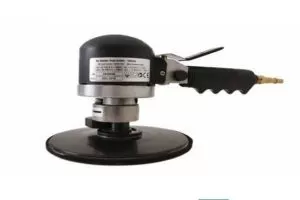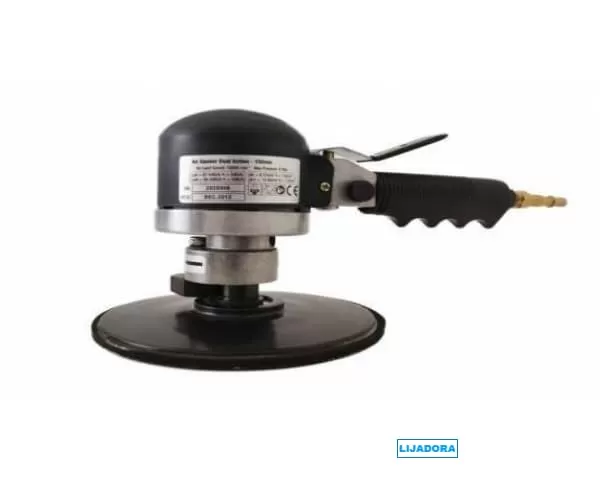Why Buy an Orbital Sander ?
Today, more people dare to do their own home repairs and renovations. Thinking about them, it has been evolutionary the improvement of the tools at the present time, in order to make them more efficient, practical in their use and manageable for any type of people.
- These tools are no longer exclusive to professionals, but are available to anyone who, with only a basic knowledge of the tool and a little instruction in its use, can achieve the final result of a professional’s work.
- In do-it-yourself work or projects, carpentry, metal polishing, and other projects in which a good final finish is necessary, it is certainly necessary to apply sanding.
- This task is usually tedious, due to physical exhaustion from repeated strokes, scratches or marks from sanding on the surface, unevenness of the surface, dust, time spent sanding on the surface, difficulty in sanding some places such as corners and rounded edges, among other factors.
- For such a task, a tool has been designed that can be the protagonist of our projects. Its name is Orbital Sander. Its compact ergonomics, versatility, its powerful and silent motor and its easy handling make it an excellent ally to carry out our sanding and polishing projects.
- The Orbital Sander is a rotating device driven by an electric motor, whose main function is to sand, polish and even strip surfaces. This sander has as a fundamental characteristic to have a rotary movement in the disc, and at the same time it also generates an elliptical or vibratory movement in its head.
- This rotary and orbital movement allows sanding in an even and uniform way, it also avoids passing through the same place twice, in this way we avoid leaving circular or irregular marks that go against the grain, and with this we compromise the result of the final finish.
Brands of Orbital Sander and Also Roto Orbital Sander
These are some of the pioneering brands in the world of orbital sanders:
Makita Orbital Sander
- The electric motors of the sanders built by Makita with large sealed ball bearings, allow a longer life of the tool. The variable speed control dial allows the user to match the sanding speed to the material.
- It has a large two-finger trigger switch with a conveniently located lock button for continuous use and increased operator comfort. Adjustable front handle allows sanding in corners and confined areas
Tacklife Orbital Sander
- The adjustable speed dial helps you monitor the exact right speed for the sanding job you need to do. This sander provides efficient work with 3.0 amps of power generating 13,000 orbits per minute.
- A paddle switch located on top of the sander allows for easy on/off switching during application, the switch can be activated by natural palm pressure.
- High performance dust collection keeps you in a clean working environment. With a compact size and ergonomic design, this sander can easily reach into tight spaces and maximize user control, ideal for the DIY enthusiast.
Black and Decker Orbital Sander
- This brand offers an orbital sander with a compact size and ergonomic design that fits into small spaces and maximizes user control. This sander offers a high performance dust collection to provide a clean work surface.
- The Black & Decker orbital sander features paddle switch activation for easy on/off switching during application.
Bosch Orbital Sander
- The orbital sanders of this brand have a variable speed control with ergonomic positioning; Maximum comfort for the user due to the small size with optimal weight and fine shape.
- Aluminium cover for high quality and stability; integrated dust extraction due to dust box; sandpaper plate (brake prevents damage to the workpiece. Bosch Micro Filter System: Mobile with perfect extraction.
- Velcro fastener for quick change, comfortable sandpaper sheets
Dewalt Orbital Sander
- Dewalt orbital sanders are designed for professionals and to meet the highest demands for finishing quality. Their designs are robust and resistant.
- They have a variable speed electronic system and a sealing system for motor protection. It also has a good dust collection system.
Orbital Skil Sander
- The tools of this brand are exceptional, and speaking of their sanders is no exception. However, we would like to highlight their multi-function sander: The Fox 6-in-1 multi-function sander combines 6 different sanding machines into one.
- It combines a delta, orbital and eccentric sander with three special accessories that allow you to work in the most difficult to reach areas, including an accessory for sanding curved surfaces. This allows a wide variety of tasks to be carried out.
- This sander can do everything from detail sanding in corners to rapid material removal on large surfaces, and from furniture sanding to handrail sanding. It has a robust bag with three different sanding discs, three sanding accessories and 15 sanding sheets.
Einhell Orbital Sander
- The Einhell orbital sander is light and easy to handle. It allows a simple and quick change of abrasive paper by means of Velcro. It also has large ergonomic grip surfaces.
- It has an integrated dust collection system with container and vacuum connection, as well as many other practical functions.
KKmoon Orbital Sander
KKmonn offers compact and easy-to-use orbital sanders. They are very light and their casing is made of aluminium. It has models that are designed to be used with air for operation.
- Orbital Fixkit Sander
- The Fixkit brand offers an excellent line of high quality pneumatic orbital sanders. Among its most outstanding features is its ergonomic design, which fits perfectly in the hand and allows for easy handling by the operator.
- They have a maximum pressure of 90 psi; Working pressure: 6.3 bar; Speed of 10000rpm; Air consumption of 0.35 m³/min; Hose length is 1m, and noise level is 100db.
Dexter Orbital Sander
Dexter orbital sanders have variable speed: between 6000 and 12000 rpm. It also has an automatic clamping system and qualitative clip, aluminum base, with cable suction function. It has a dust extraction system with a collection bag and an adapter tube for it.
Also checks Virutex brand sanding machines and Parkside orbital sanding machines
What is the Orbital Sander Used For ?
- The applications and uses of orbital sanders cover a wide variety of work areas.
- In the construction sector, it is widely used for roughing and finishing apparent concrete, leveling concrete surfaces, polishing floors, smoothing edges or plaster moldings, sanding or smoothing existing roughness in plaster and concrete walls, among other uses.
- In the woodworking or carpentry sector, it is an essential and widely used tool in any carpentry workshop. This tool allows us to achieve high finishes, can sand wood efficiently and even has the ability to polish the wood.
- In the automotive sector, it is booming, as its use and application has expanded in this area. The contribution that the orbital sander offers to this field responds to the need to sand the surface of the bodywork, in order to smooth and prepare it for priming or painting.
- Due to its orbital and elliptical movement, it has the ability to remove the residue removed from the automotive restoration putty, this allows less accumulation of debris on the sanding disc.
- It is also used in this area for polishing, as it has the ability to achieve ultra-fine sanding jobs and without leaving marks that can damage or compromise the final finish. Special felt or wool discs can be added for extreme polishing with wax. The use of belt sanders is not recommended for this purpose.
Electric Orbital Sander
The electric orbital sanders are all those that need electrical energy for their operation. The energy supply of these sanders can come from 2 types of sources or methods of electrical supply.
- These sanders are named according to their method of feeding: Electric orbital sander with cable and battery orbital sander with rechargeable battery.
- Power sanders are the best, fastest and most effective way to sand, smooth and polish wood among other materials such as concrete and metal. As its name says, it has an electric power cable.
- These are compact and lightweight tools, usually weighing from 2.5Kg to 4.5Kg.
- The electric orbital sanders with cable, have powerful motors, are designed for light, medium and semi-heavy work.
- As its name says, its method of power supply is by means of an electric cable, which has a plug or connector at the tip that is free to be connected directly to the wall outlet or an electric extension cord.
- The battery or rechargeable orbital sanders have similar characteristics to many other orbital sanders, however, the main difference lies in the power source, this lacks wiring because their power comes from rechargeable batteries.
- These machines are normally used to perform medium and smooth sanding jobs, they are super effective in preparing a surface quickly and evenly for subsequent finishing. Thanks to its lack of wiring, it allows us versatility and greater mobility.
- They can come in different powers and their operating time will depend on the battery and its charging capacity, normally its duration is approximately one and a half hours. Their batteries are usually lithium-ion.
- They regularly reach between 11,000 and 22,000 oscillations per minute and are usually light, usually no more than 3.5 kg. They have the best results with speed pre-selection in applications on materials that require a specific speed.
- The battery orbital sander is compact and suitable for any type of corner, allowing flexible work in any situation thanks to its rechargeable battery.
- For continuous work it is recommended to have several batteries, that is to say to work with fully charged batteries while the batteries that were used and their charge was consumed are being charged. This way you can be prepared and will not stop your projects.
- Most of today’s battery powered orbital sanders have a micro-filter system for an efficient vacuum system.
- This avoids the accumulation of dust and residual material from sanding inside the electric motor and its mechanisms, and also protects the user, since it vacuums a large part of the sanding dust emitted while working on a given surface.
Orbital Wall Sander
- The orbital wall sanding machines are designed to work on large flat surfaces such as walls and ceilings up to three metres high. It is a practical and universal helper for interior finishing and renovation for every demanding DIY enthusiast.
- Its ergonomics allow it to cover large areas quickly and efficiently. It has a large sandpaper plate with a practical loop and hook system. Thanks to this system, the abrasive discs can be easily mounted and changed
- It has the ability to adjust the length continuously, this can be regularly adjusted between 1550 mm and 1950 mm, this allows to work comfortably large heights and narrow places or edges of difficult access.
- It works very well for removing wall coverings and ceramic wallpaper residues, tile adhesive, sanding walls and plasterboard, for sanding large wooden surfaces.
- The optimum adjustment of the sanding speed to different substrates to be processed can be adjusted quickly and easily by means of speed control.
- It also has a system for collecting the dust emitted during sanding.
- The dust that is produced is sucked up by a practical suction system in connection with an additional suction device (dry vacuum cleaner) directly from the abrasive disc and thus enables a clean workplace without the release of dust at all times.
Palm Orbital Sander
- The orbital palm sander, refers to a compact electric sander, perfectly designed to be used with one hand and with excellent sanding performance with very little manual pressure applied by the operator. The ergonomic rubber coated handle prevents the hand from slipping.
- Regularly the diameter of the sanding disc is 5 or 6 inches.
- It has a built-in regulator for speed control, it is easy to operate and reduces operator fatigue while offering the best performance, high speed in a powerful and universal sanding machine, Free speed can reach up to 13,000 revolutions per minute or more depending on the model.
- The hook and loop mechanism keeps the sandpaper firmly attached to the sanding pad. To replace, just remove the old paper and press down on the new sandpaper.
- Regularly used for light sanding and polishing work on wood and metal. Orbital palm sanders may be equipped with an electric power cord to allow operation, other models use rechargeable lithium batteries as the power supply method.
- Palm orbital sanders have a variant that uses a different method of power supply for operation. This is the case of the Air or Compressed Air Palm Orbital Sander.
- These orbital palm sanders use compressed air to drive their operation. It has a regulator incorporated for the control of maximum speed of 10000 rpm per minute, the air orbital sander will be your best helper for a long lasting service in different operation areas.
- It has an on/off switch of button type, much easier and considerate for its operation. By turning the speed control knob, adjust the speed to the most suitable speed, use it easily.
- It is ideal for bodywork, furniture, metal products and other components, widely used for rough grinding, semi-fine grinding, grinding and slotting and cutting.
- It weighs approximately 3 pounds. It has an air consumption between 5 cfm and 10.5 cfm, and an air pressure of 90 PSI.
- The air orbital sander is made of a composite plastic body and is quite light. It is best used for all kinds of metal products, polishing the processing residue after welding slag, solder and rust.
- Be sure to use the lubricating oil that comes with it for better performance.
Orbital Sander with Vacuum
- There are several models of orbital sanders today, different manufacturers offer their product lines and tools with diverse and specific characteristics. One of the characteristics that can stand out in some models is that they have a vacuum cleaner included in their ergonomics or attached to it.
- The purpose of including this vacuum cleaner is to absorb the dust emanating from the sanding work, which is very beneficial for many reasons. It protects the user from being exposed to excessive dust. This avoids health problems at the level of the lungs and respiratory system for both the operator and people in general.
- Avoids dust accumulation in the mechanisms or internal parts of the sander, thus preventing its malfunction or subsequent deterioration. The dust that gets into the internal parts of the sander’s motor can dry out some bearings or cause great damage to them in some cases.
- This may or may not include the dust collection system.
- Orbital Sander with Bag
- Another feature that we can highlight in some orbital sanders, is to have an accessory or complement of one, which is ready to receive and contain the dust sucked by the vacuum cleaner of the sander, resulting from the sanding work. This is the collection bag.
- This bag is perfectly designed to be attached to the vacuum cleaner of the sander or to be coupled to its collection system. This is a great advantage since it contains the dust inside it, thus avoiding the excess of dirt and dust on the surface being sanded and helps to maintain order in the work area.
- These bags can be made of felt, which are normally arranged in plastic holders designed to receive them and be connected together in the orbital sander or the hose that comes from it with the collected dust. We can also find the fabric bags. They are very resistant and reusable.
- The cloth bags have an adapter on the nozzle to be connected to the vacuum cleaner of the sander or to its collection system. We can also get the so-called complete dust collection drawers, which function as a storage for the vacuum bags of the orbital sander.
- Orbital sander vacuum bag options include paper bags.
- There are different types of orbital sanders and various brands, and with them several options for dust collection.
Orbital Sander with Water
The operation of this sander is conditioned to the use of pressurized water. It handles an average of 3,000 psi. Uses a push button switch to turn the sander on or off. It has a regulating valve at the water inlet.
The orbital water sander can be used wet or dry. Uses standard vacuum hook type paper through water feed pad, comes with water feed hose. Save up to 50% wet sanding time while creating a flawless finish.
Typically reaches 10,000 revolutions per minute. They are very light, since when working with water they lack an electric motor and many other mechanisms. They usually weigh about two pounds. With a noise level of 80 DBA.
Some tips for its operation:
- Add 2 or 3 drops of liquid detergent to the water to lubricate the sandpaper and help remove the clippings.
- With the tool in operation, turn the brass thumb screw counterclockwise until it is completely open.
- Run when water reaches the tool. Now turn the wing nut in a clockwise motion until the desired amount of water flow is achieved. Too much water will cause abrasive to the hydrofoil, while not enough will cause the tool to dry out or stick to the surface.
- You will get a better overall finish if you use non-holed sandpaper. Using non-holed sandpaper also helps to minimize the possibility of deeper scratches caused by holes in pre-punched sandpaper.
- The only damage to your tool will come from poor air quality and immersion of the tool in standing water. Make sure the water traps are empty and your air dryer is working properly.
- If your sander will be idle for a period of time, it is recommended that you remove the pad and spray lubricating oil (such as WD40) in and around the engine. This will help prevent rust deposits from forming and prolong the life of the tool.
Orbital Sander for Concrete
- This type of orbital sander is intended for work on concrete, it is designed for rimming or rounding corners on hard surfaces such as: stone, concrete, concrete, marble, among others. There are small models of these orbital sanders, ideal for sanding and smoothing walls.
- These sanders even have the ability to polish the concrete to a high gloss. Their powerful electric motors regularly have rotation speeds ranging from 9300 to 13000 revolutions per minute. With an absorbed power that can be from 1200w to 1500w.
- For sanding and polishing work on concrete it is very common to use orbital sanders. Orbital sanders come for dry work, wet work and both functions and it is also common to use water sanders for work on concrete.
- In the case of floors, there are special orbital sanders for concrete, granite and marble floors.
- A variety of sanding pads are required to sand a concrete floor. How many and what types of pads are required depends on the sander you choose and the finish you want to achieve. Each sander has a different series of sanding pads that are designed for use on concrete.
- You will start with a coarse grit pad. Sand the floor once and then switch to a finer grit pad. The finer the sand on the sanding pad, the more polished the floor will become.
Orbital Sanders for Wood Sanding or Orbital Polishing
Wood sanding is usually the part of the process that tends to be a little more tedious. Having the right tool for the job guarantees a better finish, less time spent and smoothness of work.
Orbital sanders have become essential tools for today’s carpenter and cabinetmaker. The most used for wood sanding are the orbital sander, palm orbital sander, random orbital sander and rotor orbital sander.
Wall Sanding with Orbital Sander or Rotor Orbital Sander
- When sanding a wall with an orbital sander, it is necessary to first take into account the necessary safety measures and the appropriate safety equipment for this work.
- Plan what you are going to do very well. Analyze what material you need to remove. If it is a simple sanding on washed and unwashed surfaces, a soft sanding with paper of the appropriate weight for each material will be sufficient.
- Common sanding with an orbital sander is suitable for removing acrylic paint, synthetic enamel, lacquer, varnish and other similar materials in single layers, and even allows you to create special pickling and wearing effects easily.
- However, some materials such as lacquers, which are applied in two or more layers, plasticized and shellac need, before sanding, to be removed with solvents suitable for the material and the surface. After application you should wait for it to act and spatulate out the residues.
- After choosing the wall sander that best suits your needs now it’s time to choose the sandpaper, this will depend on the work and finish you want to achieve.
- If you need to sand a cardboard or plaster wall we recommend that you use 180 or 240 grit sandpaper, you need to polish or sand a plastered wall, in this case you can use thicker or thinner sandpaper. First use a thicker sandpaper such as 80-100 grams and then a thinner sandpaper 150-180 to finish.
- The recommended way to sand a wall is from top to bottom and from side to side, with a linear path and with a smooth and constant movement of the orbital sander. Use palm or delta orbital sanders for corners or hard-to-reach places.
Orbital Sanders or Orbital Polisher for Smoothing Walls
You don’t need to be an expert on it, what you need are the right tools. The recommended orbital sanders for smoothing the walls are Boom orbital sander, roof and wall orbital sander, palm orbital sander, rotor orbital sander and delta sander.
Orbital Sander for Iron
Orbital sanders are ideal for polishing metal, most orbital sanders have the ability to sand and polish the metal, everything will depend on the type of metal, the desired finish and the type of sandpaper you use, which should be appropriate for the material to work.
Orbital Sander for Roofs
- These orbital sanders are specially designed for ceilings and walls, they are for covering the work of sanding large flat surfaces. They have a telescopic handle to achieve greater height, up to 3 mts.
- Normally their sanding plate is round, but there are also triangular ones to access corners and nooks. They commonly have a dust collection system, which consists of a vacuum cleaner, pipe or extraction hose and collection bag.
- Other models have part of these accessories and the rest are bought separately.
- The dry construction sander has an ergonomic handle directly above the sanding plate. Together with its powerful motor with continuous speed control, this allows for controlled and powerful work at the same time.
- The switch has a locking function, the sponge pads and the sandpaper are easy to change and quickly interchangeable because of the Velcro fastener system.
Car Orbital Sander - Double action orbital polishers work by oscillating several times per second in one direction. This allows you to cover all parts of your vehicle’s paintwork very precisely and safely, with little risk of damage to the paintwork.
- These sanders are designed for sanding and polishing car bodies. The most common ones for this task have a disc diameter of 6 or 7 inches, and a variable speed system to handle the different stages of sanding and polishing the car.
How to Use an Orbital Sander ?
- You should be aware and take all the necessary safety measures before starting to use your orbital sander, remember that it is a power tool.
- Turn on the sander and let it rotate at the desired speed before making contact with the material.
- Position the sander on the material to be sanded.
- The sander should not be tilted over the surface of the material as this may leave marks.
- Do not tilt the sander sideways to attack low spots.
- Always move the sander in a left-to-right action with the direction of the grain.
- Do not press the sander down, let it sand under light pressure only.
- Do not allow more than 1/4 to 1/3 of the sanding pad to leave the surface of the wood.
- It is recommended that you stop sanding work from time to time to inspect the surface, the work done, and the work remaining to be done.
- When sanding work is complete, the sander should be turned off and held until the disc stops moving before it is lowered or placed on standby.
How Does an Orbital Sander Work ?
The operation and orbital movement is produced by simultaneously spinning the sanding disc and moving it in small ellipses by means of its powerful electric motor.
This ensures that no individual part of the abrasive material travels the same path twice during the same rotation. Due to this sanding action, the tool does not leave any swirl marks and is not sensitive to the direction of the wood grain.
How to Make a Home Orbital Sander ?
To make a home orbital sander there are many ways, and they can also be made with different materials that we have at hand, you just have to get your creativity going.
This is a prototype of a homemade orbital sander:
We’ll need:
- 1 blender motor.
- Approximately 20 cm of 3-inch PVC pipe.
- 1 3-inch PVC female plug.
- 1 3-inch PVC blind cap.
- 1 Circle of wood or MDF of 1 cm thick and a diameter of 3 inches.
- 1 PVC female ring 3 inches by 8.0 cm high
- 1 Switch.
- 1 spare handle of an electric machine or damaged with its fastening screw.
- Cable with connector on one end.
- Electrical insulation tape.
- Fabric
- Glue for PVC.
First, we mark the center of the external part of the PVC female plug so that it matches the axis of the blender’s motor and we also mark the two fixing points with screws that the motor has.
We proceed to drill these three holes (the one in the shaft and the two for fastening) and we will install the motor inside this plug with its own original motor screws, leaving only the quadrant on the external side of the motor, and the motor protected inside the plug.
Then we will cut a section of 3-inch PVC pipe to 10 cm and attach it to the plug where the motor is located. Then we will place a 3-inch female coupler at the other end of the 10-cm section that we have just placed and cover the rest of the uncovered section.
We will then cut this female coupling to the length of the uncovered portion of the 10 cm section, so that it has double protection.
At the other end of this female coupling we will place the blind PVC cover and mark, drill and install the switch.
We must fix the switch to the cover with glue, and the cover to the uncovered socket. Then we will make 9 holes around the female plug where the motor is. 8 of them for ventilation and the remaining one to fix the handle or grip perpendicularly to it. Then fix the handle.
Then we will connect the cable to the switch and motor, and isolate the joint points with electrical insulation tape.
To the protruding quadrant on the external side of the female plug, we will fix a circular coupling of approximately 2.5 inches to which we must fix the 3-inch wooden circle.
This fastening is done by means of 2 or 4 screws placed on the internal side of the metal coupling, so that no screw protrudes from the external side of the wooden circle, since this will be our support disc for the sandpaper.
We will fix with glue a circle of cloth to the wooden disc for a better support and performance of the sandpaper. We will cut a circle of 3 ½ inches from the desired sandpaper and place it centered on the support disc.
The remaining edges of the sandpaper will be cut out to be folded out as tabs and the PVC ring will be placed around these tabs against the disc.
This ring will serve as a tensor and fastening system for our sandpapers, if you wish after placing the sandpaper and the ring can be screwed to the wooden disc for greater support.
Finally, attach the plug where the motor is and the other part where the switch is, and you can connect and use your homemade orbital sander.
Note: you can use a speed selector instead of a switch to take advantage of the different speeds that the blender motor you get can offer.
How to Disassemble an Orbital Sander ?
To disassemble an orbital sander, it must not be in operation and you must make sure that it is disconnected from the electrical outlet.
- We must remove the three screws from the upper housing, and lift the lid with a slotted screwdriver, being careful not to break any plastic parts. Removing this top cover exposes the location of the coals, top bearing of the electric motor shaft, switch, power cables and the series circuit of the orbital sander. Part of the field can also be seen from this area.
- To remove the motor we must disassemble the bottom part, for this we must place the orbital sander upside down so we can see and remove the 4 screws that the sanding panel has.
- After removing these screws we will remove the sanding panel or plate and a housing that protects the bearing at the bottom of the motor will be exposed, this is fixed with two screws, we will proceed to remove them. When removing this casing, the fan and the lower bearing will be exposed.
- To remove this bearing we must lock the fan with a flat screwdriver and proceed to remove the shaft screw, when the screw is out you can remove the bearing and the fan.
- The next step is to remove the 4 screws that hold the housing laterally, two of these go outside the housing and two inside it, which were left exposed when the top cover was removed.
- By removing these 4 screws, we can separate the housing. Removing them will expose the electric motor of our sander.
- If you wish to disassemble the motor, it consists of two parts: the magnetic field and the induced shaft. The latter has three bearings from which we have already removed one to take out the fan. To remove the bearings from the shaft, you must use a hydraulic press to avoid damaging or forcing the parts.
How to Change the Carbons of an Orbital Sander ?
To change the coals on an orbital sander, it must not be in operation and must be disconnected from the power supply.
- Then proceed to remove the three screws that have the upper housing protect the top of the motor, in this area are concentrated the internal electrical parts of the sander.
- When removing this casing, the area where the coals are located will be exposed, there are usually two of them, and they will be arranged around the magnetic field of the electric motor of our orbital sander.
- To remove the coals, we must disconnect its terminal from the carbon holder from the magnetic field, then we must press with a fine flat screwdriver the spring that holds the carbon so that it can come out.
- We check the state of the coals and replace them if necessary. Repeat the operation in reverse after replacing the coals to reassemble the orbital sander.
What is a Pneumatic Orbital Sander For ?
When we talk about pneumatic orbital sander, we are referring to those orbital sanders that use compressed air to operate, this air is driven and processed by a compressor.
These orbital sanders are widely used in woodworking for medium and smooth sanding and polishing jobs. This tool is also widely used in automotive body repairs, especially in the repainting and polishing process. They have an average air consumption of 4.30 cubic meters. Noise level: 85 dB and air pressure: 90 Psi
The orbital air sander works with a high degree of free speed of 1,500-2,600 rpm, to polish a wide range of surfaces such as: paint, metal, plastic, among other materials. It is used to obtain a professional high gloss finish.
Sanding Sheets For Orbital Sanders
Today there are several types of sanding sheets for orbital sanders with specific characteristics, designed in different materials and for different purposes. They can be rectangular, square or circular, this will depend on the shape of your orbital sander.
Durable sanding sheets for all types of sanding work, with perfect fit. They are available for dry work, in water and for both functions. Disc sanders may or may not have holes.
The sanding paper is connected to a rectangular pad on the bottom of the orbital sander. The motor moves the pad in small circular orbits. Easy to operate.
You can use regular sandpaper, and measure its size by the portion of a standard 9 “x11” sheet of sandpaper. A 1/4 size uses a 1/4 of a regular sheet, a 1/3 uses a 1/3 sheet, and a 1/2 uses a 1/2 sheet. The holes on the bottom of the much used orbital sander help remove dust from the material as you sand.
In our online shop we show you the types of sanders and discs you can use to work with the orbital sander and other models.
Types of Orbital Sanders According to their Composition and Function:
- Aluminum oxide: this is a round grain, which has tenacity and is highly durable. It is indicated for sanding materials such as metal and wood. As well as for sanding plastered walls.
- Zirconium oxide: This is a grain with great uniformity, great tenacity and very high durability. It is ideal for sanding stainless steels.
- Silicon Carbide: This synthetic abrasive has a characteristic shiny black colour (iridescent), it is the sharpest and hardest material used in coated abrasives.
Types of Orbital Sander Abrasives According to their Grain Type
- Coarse Sandpaper: This type of sandpaper includes the following numbers: 80, 60, 50, 40, 36, 24, 20, 16, 12.
- Medium sandpaper: This type of sandpaper covers the following numbers: 280, 240, 220, 180, 150, 120, 100.
- Fine sandpaper: 600, 500, 400, 360, 320.
- Extra fine sandpaper: This type of sandpaper covers the following numbers: 1500, 1200, 1000, 800.
- Ultrafine sandpaper: 3000 and 2000.
The most common dimensions of orbital sander sandpapers are:
- Round: 2, 3, 4, 5, 6 and 7 inches / 180 mm, 150 mm, 125 mm.
- Rectangular: 93 x 230 mm, 93 x 185 mm, 80 x 123 mm, 115 x 240 mm.
We must also highlight the delta orbital sander sanders: these have a triangle shape, are ideal for sanding in corners and corners.
Most common dimensions of sanders for Delta orbital sanders: 105 x 105 mm, 100 x 147 mm, 51 x 95 mm.
How to Place the Sandpaper of an Orbital Sander?
- This sanding tool offers full freedom in choosing the type of sandpaper, thanks to its Velcro fastening mechanism that allows easy and practical change of the sanding sheets. Attaching the sanding paper to an orbital sander is relatively easy and only takes a minute to complete.
- First, make sure the orbital sander is disconnected from the power supply, then place it on its side on a flat surface so that you can access the bottom of the sander where the paper is to be removed.
- You should hold the paper in either corner and remove it from the orbital sander. Remove the old sandpaper and remove it completely. Inspect the area where the sandpaper was located. Remove any excess dust and dirt.
- Place the new sandpaper over the orbital sander pad, align it, and make sure it is the proper size.
- Remove the paper cover and press the sandpaper into place on the sander with the sticky side down and the sandpaper side out.
- Push down firmly on the sandpaper. Run your fingers over the entire area so that it can adhere to the pad. It is recommended that you test the pad for a few minutes on wood and then inspect the new pad for tightness.
Discs Using an Orbital Sander
Orbital sanders accept peelable and adhesive PSA (pressure sensitive adhesive) abrasive discs, while others use Velcro (hook and loop) discs. PSA discs are less expensive, but hook and loop discs are much faster and easier to change and reuse
Parts Used by an Orbital Sander
The different manufacturers of orbital sanders offer spare parts for these, among the most common parts to be replaced, either due to wear or other damage. We have, the carbons, the power cable, magnetic field, drive shaft, bearings, the housing, screws (for metal and for plastic) and switches.
Reference Prices in Dollars for Orbital Sanders and Second Hand Orbital Sanders
Electronic Orbital Sander, 190W, 4000-11000 Rpm, 93 x 185 mm – Dollars 77,40
Bosch PEX 220 A – Orbital sander (220 W, sanding plate Ø: 125 mm – Dollars 56,91
TACKLIFE Orbital Sander, 350W 6 Speed Adjustable – Dollars 39,99
Reviews on Orbital Sanders
- I own a carpentry shop. Previously our carpenters did the soft and medium sanding to make sure they got the best finish, but it took a long time.
- We made the investment of buying three orbital sanders, and now we were able to reduce work effort and hours of work, now our delivery times are shorter, and so is production. I would buy it back.
- I am a carpenter by profession and a lover of DIY, I love the finish that the orbital sander provides, it is light, compact and easy to use, the result of the sanding is impressive, it has many advantages.
- It gives you a clean finish, it is uniform and does not leave any marks on the sanded surface, it is strong, with a hard shell, to make it stronger.
- It is hard to believe that they have such a powerful motor, being so light and compact.
Features of Orbital Sanders you can find in our Online Shop
- Some orbital sander models have a sandpaper punch plate that allows you to convert a standard sheet of sandpaper into one with holes designed to fit on the bottom of the sander.
- Other models of finish sander or orbital sander incorporate a triangular pad extension for sanding in tight corners.
- Very easy to handle.
- They have orbital sanding action, while others use a pivoting unit that moves the pad in a small arc.
You can find these versatile orbital sander models, also called finishing sanders, in our online shop. The best and cheapest prices are shown here.
Finish Sander Wanted as One of the Top Wood Sanding Machines
There are styles available that you can buy on offer: the angle head style where the disc runs parallel to the motor and the vertical style where the disc runs in a plane perpendicular to the motor and the pneumatic orbital sander for example.
Hand sanders are another variation of this finishing sander, but they run at much lower speeds than the regular sander. A sander should not be used for polishing, as the high speed could burn the paint.
How to Use an Orbital Sander and What Is It For ?
The orbital sander is also known as a finish sander or a wood sander. We find for you 4 recognized brands that are the Makita orbital sander, the Dewalt orbital sander, the Bosch orbital sander and also the Black and Decker orbital sander. You will find all of them in our online shop. Find the sander of your preference in its different prices and models
Orbital Sander or Random Orbital Sander ?
Regardless of the task, sanding is usually the part of the process that most of us don’t really enjoy. Having the wrong tool for the job only makes things worse.
When you’re ready to put the finishing touches on a wood project and you’re looking for the right power tool, you’ll probably want to get an orbital sander, or will it be a random-orbit sander? They are different tools, and which one is right depends on what you are looking to do.
Understanding the big differences between these two small sanding machines will help you make sure you have the right sander for the job at hand.
- The orbital sander’s revealing square foot allows you to get to the corners and against the edges. Although random, the pattern created with 100 grit paper clearly shows that extra care is still needed when sanding through the grain
- The finishing sander is the older, simpler and less expensive of these two tools. It generally has a square foot that will take a quarter of a 9 × 11 sheet of sandpaper.
- As a result, these tools are often called quarter sanders. (There are also uses for half sheet orbital sanders.) To create the sanding action, the foot of the sander vibrates rapidly in small circles or orbits.
Advantages of Using the Orbital or Orbital Speed Sander
- One of them is the variable speed that serves for a slow and delicate work or a faster and heavier work.
- Most use a bag to collect sanding dust.
- They are also used for sanding or grinding metals.
- It is capable of removing materials in plastics, wood or concrete when used with the right attachment such as a stone, disc or wheel.
- The best feature in the use of the orbital sander is its square shape, which allows it to be placed in the corners and against the edges.
You can also use a regular cut of sandpaper to fit it in place of the custom-made random orbital sanding discs.
Orbital sanders are not too aggressive in use, so it is difficult to remove too much material.
Compared to hand sanding through the grain or a belt sander, they leave less obvious cross grain marks, which means that it is more difficult to ruin your work.
Performance and sanding pattern differ from mark to mark, so be sure to test the sanding pattern before assuming yours will not leave visible cross-scratches.
Disadvantages to Using the Random Orbit Sander
The main disadvantage is that the sanding marks are usually more visible compared to a random-orbit sander. Another disadvantage is that they do not remove a large amount of material. And while some designs are better than others, the clamps that hold the sanding paper in place are less convenient than the push in place options used for random-orbit sanders.
Best Uses of Orbital Sanders
- Orbital sanders are useful for places where a random-orbit sander would not fit, and when only light sanding is required.
- They are perfect for preparing a surface for painting or sealing, or for removing a coat of paint. They’re also useful when you’re repainting a wood floor and need to get the baseboards to the corners.
- The oscillations of the random-orbit sander as it rotates do not create a distinct pattern. This allows the tool to be used without concern for the direction of the grain. When both tools are equipped with 100 grit paper, the random-orbit sander removes more material than when the orbital sander is used.
- Now, the mainstay in the use of power sanders is that this tool was widely used in the automotive field before it became common for working wood.
- Using a circular sanding pad that is typically 5 inches in diameter. (6-inch versions are also available), the random-orbit sander rotates but does not turn on a single consistent shaft like a typical disc sander. Instead, the shaft rotates and also oscillates off-center, creating a random scratch pattern that is never exactly the same.
Advantages of Using it Over Using a Regular Orbital Sander
- Due to their unpredictable pattern, random orbital sanders create a less visible cross-section.
- A random-orbit sander may not be the workhorse of a large belt sander, but it can remove much more material than when using an orbital sander.
- Many random orbital sanders have variable speed switches for less aggressive sanding.
- The hook and loop sanding discs most commonly found on random-orbit sanders are easier to change than the notebooks attached to orbital sanders.
Disadvantages to Using a Finishing Sander - The biggest disadvantage of random-orbit sanders is their round sanding surface, which makes it impossible to access the corners. In addition, they can remove too much material if it is held too long in place.
- On average, they cost about twice as much as orbital sanders, but their improved performance offsets the price.
Best Uses for Orbital Sanders
When a decent amount of stock needs to be removed, a random orbital sander is the preferred tool. It can also be used for large jobs, such as finishing a wood floor, and smaller jobs such as cabinets.
Related Products in ALPHAPEDIA
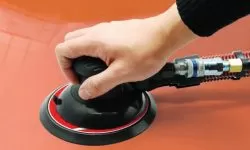
AIR or PNEUMATIC SANDER: Great Price on Qualified Products
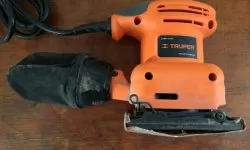
ORBITAL TRUPER SANDER: Great Price on Qualified Products
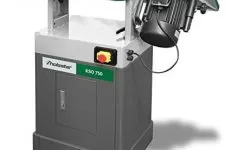
ELECTRIC SANDER: Great Price on Qualified Products
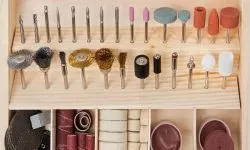
ACCESSORIES FOR Orbital and Drill SANDING MACHINES
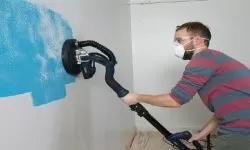
GIRAFFE SANDER: Brands like Makita. Models and Prices
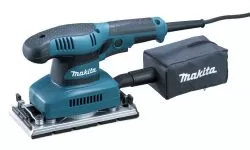
MAKITA SANDER: Great Price on Qualified Products
Other Topics of Interest in ALPHAPEDIA

FREE FLOWER ARRANGEMENT COURSE
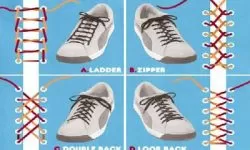
How to TIE Your LACES Step by Step ?

FREE COMPUTER COURSE

FREE MASTER DEGREE IN FINANCIAL RISKS

FREE DOCTORATE IN POLITICAL SCIENCE

💚 WHAT IS ELECTRICITY FOR ?
Orbital Sander Image
